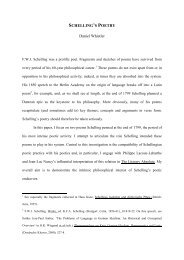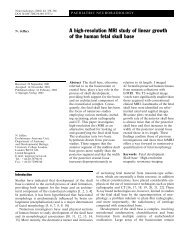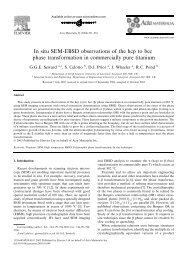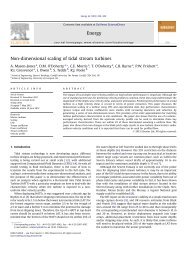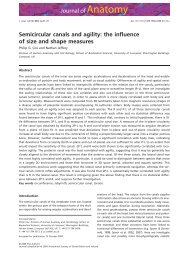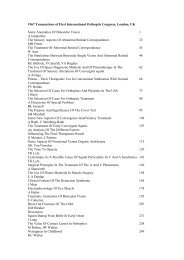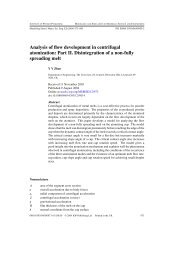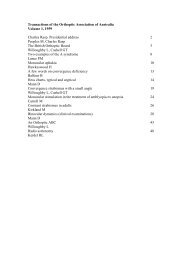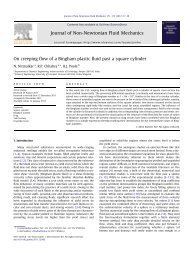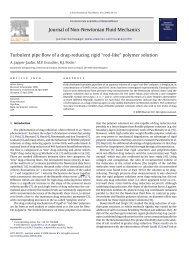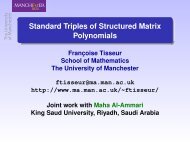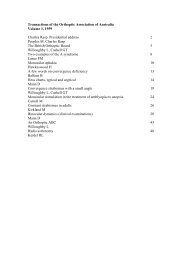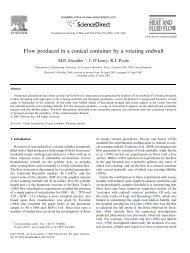Beyond the Pre-Pottery Neolithic B interaction sphere - University of ...
Beyond the Pre-Pottery Neolithic B interaction sphere - University of ...
Beyond the Pre-Pottery Neolithic B interaction sphere - University of ...
You also want an ePaper? Increase the reach of your titles
YUMPU automatically turns print PDFs into web optimized ePapers that Google loves.
94 J World <strong>Pre</strong>hist (2006) 20:87–126<br />
In contrast to Cauvin’s <strong>the</strong>ories, we find approaches that have fostered actualistic and<br />
region-specific explanations <strong>of</strong> <strong>Neolithic</strong> cultural formations emphasizing regional diversity.<br />
These ‘‘polycentric models’’ have sought to replace earlier schemes <strong>of</strong> unilineal<br />
<strong>Neolithic</strong> cultural evolution with multilineal ones, positing that <strong>the</strong>re was no single centre<br />
<strong>of</strong> cultural and economic innovations. They promote, instead, a view <strong>of</strong> <strong>Neolithic</strong> Western<br />
Asia as a fragmented world composed <strong>of</strong> distinct local cultures, which independently<br />
followed different trajectories (Gebel, 2002, 2004). This emphasis on regional diversity<br />
developed largely as a result <strong>of</strong> <strong>the</strong> ever-increasing volume <strong>of</strong> excavation and survey<br />
projects across <strong>the</strong> region that put into question <strong>the</strong> certainties <strong>of</strong> earlier schools <strong>of</strong> thought,<br />
such as <strong>the</strong> ‘‘Levantine primacy’’ school (Rollefson & Gebel, 2004), and was fur<strong>the</strong>r<br />
bolstered by <strong>the</strong> continuous enrichment and refining <strong>of</strong> radiocarbon-dated sequences. The<br />
accumulation <strong>of</strong> new dates and <strong>the</strong> improvement <strong>of</strong> calibration curves revealed much finer<br />
distinctions in regional chronologies, and significantly less overlap than previously assumed<br />
among individual sites and groups <strong>of</strong> sites that, until <strong>the</strong>n, had been considered to<br />
represent homogeneous cultural assemblages (Aurenche, Galet, Regagnon-Caroline, &<br />
Evin, 2001).<br />
One could categorize as polycentric, for example, much <strong>of</strong> <strong>the</strong> research undertaken<br />
within Turkish <strong>Neolithic</strong> archaeology, which presents <strong>Neolithic</strong> Anatolia as a potential<br />
case <strong>of</strong> independent neolithization and emphasizes <strong>the</strong> enormous cultural diversity found in<br />
this region (Özdog˘an, 1995). For central Anatolia, in particular such an approach was<br />
supported by <strong>the</strong> differences observed between <strong>the</strong> local Early <strong>Neolithic</strong> assemblages and<br />
<strong>the</strong> long-established culture-historical sequences <strong>of</strong> <strong>the</strong> Levant (Özdog˘an, 2002). These<br />
differences led Turkish prehistorians to substitute <strong>the</strong> Levantine periodization in PPNA,<br />
E(early)PPNB, L(late)PPNB/C and PN (<strong>Pottery</strong> <strong>Neolithic</strong>) with a new central Anatolian<br />
terminology, identifying five main periods under <strong>the</strong> rubric <strong>of</strong> ‘‘Early Central Anatolian’’<br />
(ECA) (Özbas¸aran & Buitenhuis, 2002) (Table 3). The principal assumption behind this<br />
Table 3 Periodization and associated excavated sites belonging to <strong>the</strong> ECA (‘‘Early Central Anatolian’’)<br />
period<br />
ECA periods (cal.<br />
BC)<br />
ECA I (Younger<br />
Dryas-c.9000)<br />
ECA II (*9000-late<br />
eighth millennium)<br />
Correlation with <strong>the</strong><br />
Levantine PPN scheme<br />
Epipalaeolithic, PPNA/<br />
EPPNB<br />
Excavated sites<br />
Pınarbas¸ı rock-shelter Epipalaeolithic burial and hearths<br />
(radiometric dates are forthcoming; Baird, 2003)<br />
E/MPPNB-LPPNB Pınarbas¸ı A (8540–8230, 3 dates), As¸ıklı Höyük >(8210–<br />
7480, 47 dates; basal level 3 undated), Kaletepe<br />
(obsidian workshop: 8290–7960, 3 dates), Can Hasan<br />
III (7600–6650, 16 dates), Suberde (7460–6770, 5<br />
dates), Musular (7480–7080, 7 dates), Çatalhöyük East<br />
(7400–6200, 122 dates)<br />
ECA III 7000–6000 LPPNB-PPNC-LN Çatalhöyük East, Suberde, Pınarbas¸ı B (6400–6230;<br />
6070–5920, 2 dates), Erbaba (6690–6440, 1 date)<br />
ECA IV (6000–5500) Early Chalcolithic Çatalhöyük West (base: 5990–5810, 4 dates), Can Hasan I<br />
(2B: 5710–5640, 4 dates), Kös¸k Höyük (5300–4720,<br />
dendro-dates, but contains stratigraphically earlier<br />
deposits)<br />
ECA V (5500–4000) Middle Chalcolithic Can Hasan I (1: 5320–5070, 1 date), Güvercinkayası<br />
(5210–4850, 10 dates), Kös¸k Höyük, Kaletepe upper<br />
(4850–4590, 4 dates)<br />
Source: Özbas¸aran and Buitenhuis (2002); The CANeW Project, http://www.canew.org/data; all dates cal.<br />
BC quoted at 1r<br />
123



